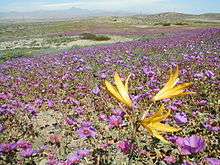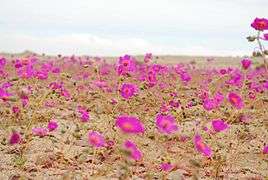Flowering desert
The flowering desert (Spanish: desierto florido) is a climatic phenomenon that occurs in the Atacama Desert,[1] Chile. The phenomenon consists of the blossoming of a wide variety of flowers between the months of September and November in years when rainfall is unusually high. Normally the region receives less than 12 mm (0.47 in)[2] of rain a year.
The blossoming occurs when the unusual level of rainfall reach the seeds and bulbs that have been in a latent or dormant state and causes them to germinate and flower in early spring.[3] It is accompanied by the proliferation of insects, birds and small species of lizard. At its height, the phenomenon can be seen from just south of the city of Vallenar to just north of the city of Copiapó throughout the coastal valleys and Chilean Coast Range from September to November.

Climatically, the event is related to the El Niño phenomenon,[4] a band of anomalously warm ocean water temperatures that occasionally develops off the western coast of South America, which can lead to an increase in evaporation and therefore precipitation.[5]
The flowering desert is a popular tourist attraction[6] with tourists visiting the phenomenon from various points around the southern Atacama, including Huasco, Vallenar, La Serena, Copiapó and Caldera.[7]
Plant and animal life
The flowering desert involves more than 200 species of flower,[8] most of them endemic to the Atacama region. The different species germinate at different times through the flowering desert period. Some of the most common species include:[9]
- Garra de león (Bomarea ovallei)
- Pata de guanaco (Cistanthe grandiflora)
- Añañuca (Rhodophiala rhodolirion)
- Schizopetalon tenuifolium
The region is also home to cacti, succulents and other examples of xerophilous plants, as well as animal species including the Tuco-tuco and the Four-Eyed Frog.[10]
Conservation
In recent years, concerns have been raised by environmental organizations about the potentially damaging effects of large numbers of tourists visiting the flowering desert, the illegal trade of native flower species,[11] and the development of motorsport.[12] Environmental organizations have suggested that these activities limit the potential for regeneration of the existing species. In response to this, the Chilean Government has established a series of prohibitions and controls, in addition to informative campaigns to the public, and especially to tourists, in order to limit the damage.[13][14]

Flowering
The phenomenon is strictly dependent on above-average rainfall, although highly excessive rainfall has been seen to limit blooming. In 1997, for example, the region saw very high total rainfall - 129.4 mm for Copiapó and 168.5 mm for Vallenar, which were respectively 978% and 433% above average. Despite this high rainfall, desert flowering was minimal.[9]
In one day in March 2015, parts of the area received 23mm of rain, causing flowering in September and October 2015.[15][16]
See also
External links
- Atacama Flowers: Pictures by Gerhard Hüdepohl, 1999 - 2015
- Atacama Flora
- Flora and Fauna of the Atacama Desert
- Video Nº10 – Flowering Desert
References
| Wikimedia Commons has media related to Atacama Desert. |
- ↑ Atacama Desert www.britannica.com Retrieved March 30, 2013
- ↑ Atacama Desert www.windows2universe.org Retrieved March 30, 2013
- ↑ Flowering desert www.livingatlaschile.com Published January 18, 2013, retrieved December 17, 2013
- ↑ NOAA's El Niño Page www.elninonoaa.gov Retrieved March 30, 2013
- ↑ Irrigation Water Management: Introduction to irrigation, RAINFALL AND EVAPOTRANSPIRATION www.fao.org Natural Resources Management and Environment Department, Retrieved March 30, 2013
- ↑ Desierto florido aumenta en 20% turistas en Región de Atacama Manuel Valencia, La Tercera, 24 September 2011. Retrieved 1 April 2013.
- ↑ The desert in bloom: a natural wonder ThisisChile.cl, 12 July 2010. Retrieved 1 April 2013.
- ↑ Atacama Desert http://www.eoearth.org/ Atacama Desert, Mark McGinley Retrieved March 30, 2013
- 1 2 Flowering Desert www.lavaguada.cl by Ricardo Ordoñez, Retrieved March 30, 2013
- ↑ The Desert in Bloom: A natural wonder www.thisischile.cl. Retrieved March 30, 2013
- ↑ Flora del Desierto de Atacama www.geovirtual.cl Retrieved March 30, 2013
- ↑ Denuncias al Dakar de Chile por destruir patrimonio arqueológico y medioambiental www.elmundo.es Jorge Barreno, January 08, 2012, Retrieved April 1, 2013
- ↑ Firman convenio para proteger desierto florido Ministerio de Bienes Nacionales de Chile, 22 September 2010. Retrieved 1 April 2013.
- ↑ Example of public information for protection of Flowering Desert Tenred.cl, 30 September 2011. Retrieved 1 April 2013.
- ↑ "Atacama Desert Blooms Pink After Historic Rainfall (Photos)". LiveScience.com.
- ↑ Erin Blakemore. "The World's Driest Desert Is in Breathtaking Bloom". Smithsonian (magazine).
Coordinates: 27°57′S 70°33′W / 27.950°S 70.550°W